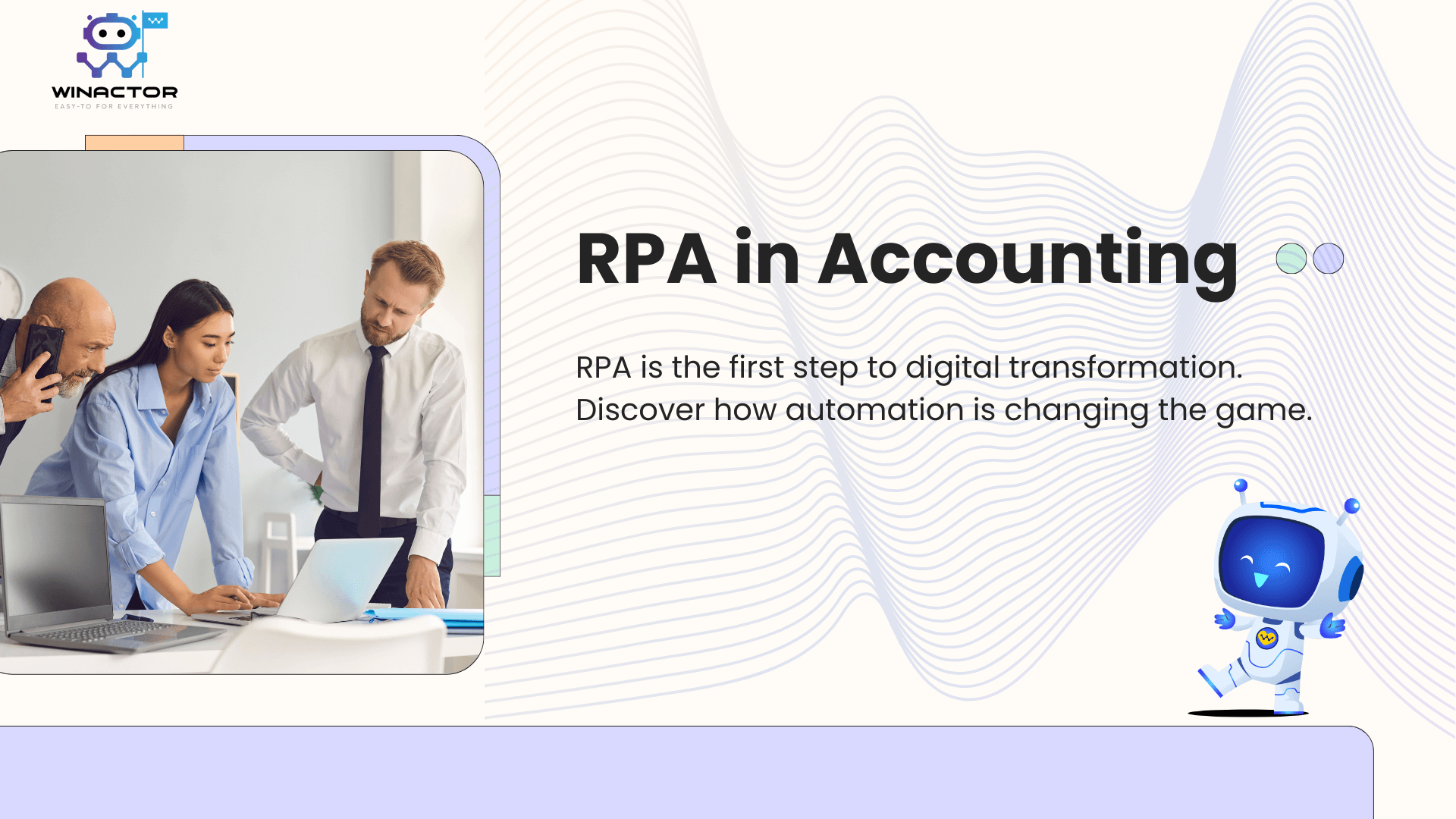Not too long ago, accounting teams were buried under mountains of spreadsheets, paper invoices, and never-ending reconciliations. Long hours, late nights during closing season, and the constant fear of missing a number were just part of the job.
Now, there’s a quiet revolution happening in finance departments – and it’s powered by Robotic Process Automation (RPA). RPA is the first step to digital transformation, replacing manual, error-prone tasks with fast, accurate, and connected processes. And because accounting work is highly structured and repetitive, it’s the perfect place to start. Let’s see how it works and why it matters.
How RPA Transforms Accounting
RPA is like having a team of tireless, ultra-accurate assistants who never sleep, never take coffee breaks, and never make typos.
These “bots” are pieces of software that follow predefined rules to carry out repetitive, structured tasks. In fact, research shows that up to 70% of finance and accounting processes could potentially be automated using RPA, which makes the field not just a good fit, but a natural launching pad for automation efforts.
In accounting, that means they can log into systems, move data from one platform to another, match records, send notifications, and even trigger follow-up actions.
The best part? RPA works with the tools you already have – your ERP, accounting software, CRM, or even email – just like a human would, but much faster.
9 Benefits of Implementing RPA in Accounting
The obvious benefits are speed and accuracy, but when you dig deeper, RPA delivers far more:
Time back in your day
Those tasks that eat up hours? RPA can handle them in minutes, allowing your team to focus on analysis, strategy, and advising the business, rather than chasing missing receipts.
Error-free processes
When numbers matter (and in accounting, they always do), even small mistakes can cause big headaches. Bots follow rules to the letter, so if the logic is right, the output is right.
Fewer Costs, More Revenue
Automating high-volume tasks means you can handle more work without adding headcount – reducing costs while increasing capacity to take on new projects or clients.
24/7 Operations with Zero Errors
Bots don’t need lunch breaks or weekends. They can run around the clock, ensuring processes keep moving without delays or mistakes.
Fraud Prevention
RPA can cross-check transactions in real time, flag unusual patterns, and alert the right people before issues spiral out of control.
Better Information Quality
Clean, accurate data means better decisions. RPA reduces the noise caused by manual errors, providing you with reliable data to work with.
Audit Efficiency
Every bot action is logged automatically, making it easier to prepare for audits. No more digging through folders for missing records – you’ve got a clear, traceable digital trail.
Scalable without hiring sprees
Need to process triple the usual transactions during the year-end? Just run more bots!
Happier teams
Nobody joins accounting to be a human copy-paste machine. Automation frees them to do work that actually engages their skills.
Real-World RPA Use Cases in Accounting
1. Invoice Processing
Invoices arrive in all shapes and sizes – PDFs, scans, emails. RPA can capture the key data (often using OCR), check it against purchase orders, and post it into your accounting system. The result? Faster approvals and fewer late fees.
2. Cash Application
Matching incoming payments to customer accounts can be tedious when remittance details are incomplete. Bots can pull bank statement data, match it with open invoices, and apply payments automatically, flagging exceptions for human review.
3. Payment Processing
Bots can verify payment requests, check vendor bank info, ensure all approvals are in place, and trigger payments. That means fewer mistakes and on-time settlements.
4. Customer Onboarding and Invoicing
From capturing customer details to setting up accounts in your ERP and sending the first invoice – RPA can do it all in one flow, ensuring quick, consistent onboarding and faster cash inflow.
5. Record to Report (R2R)
Closing the books often means gathering data from multiple systems and reconciling accounts. RPA can pull trial balances, check for discrepancies, and prepare reports – making the close faster, more accurate, and a lot less stressful.
The Future of RPA in Accounting
Right now, RPA excels at well-structured, rules-based tasks. But the next wave is already here – combining RPA with artificial intelligence (AI) and machine learning (ML).
That means bots that can read unstructured documents, spot anomalies, or even predict cash flow trends based on historical patterns.
We’re also seeing:
- Touchless processes: From receiving an invoice to paying the vendor – no human touch unless there’s an exception.
- Cloud-first automation: Easier deployment and management for global teams.
- RPA for SMEs: Affordable subscription models making automation accessible to smaller businesses.
In the near future, accounting teams might spend most of their time on strategy and decision-making, with RPA quietly running the back office.
Introducing WinActor RPA
If you’re looking for a practical, business-friendly RPA tool, WinActor is worth a closer look.
Developed in Japan and trusted by thousands of companies, WinActor is Japan’s No. 1 RPA tool designed for both technical and non-technical users. Its drag-and-drop interface makes it easy for accountants to build automation scenarios without coding knowledge.
Key advantages of WinActor for accounting teams:
- Supports 1,000+ ready-to-use libraries, so you can automate common accounting tasks without starting from scratch.
- Strong Japanese reliability and compliance focus, making it well-suited for industries with strict regulations.
- Flexible integration with ERP systems, banking platforms, and document management tools.
- Scalable from small to enterprise-level deployments, so it grows with your needs.
- WinActor Ver.7.6 marks a major step forward with Gen AI integration, bringing intelligence into automation to reduce manual effort, improve accuracy, and accelerate digital transformation.
Whether it’s invoice processing, reconciliations, or generating financial reports, WinActor can help you automate end-to-end workflows and reduce manual workloads drastically.
Final Takeaway
RPA in accounting isn’t about replacing people – it’s about removing the repetitive grind so accountants can focus on the work that really moves the business forward. With benefits like 24/7 zero-error processing, fraud prevention, better data quality, and faster audits, RPA is becoming a must-have, not a nice-to-have.
If your team is still spending hours every week on invoice entry, reconciliations, or payment runs, now’s the time to see what a solution like WinActor can do. Start small, see the results, and scale your automation to unlock your team’s full potential. Get a FREE demo or contact us today to find out how RPA can transform your accounting operations.





